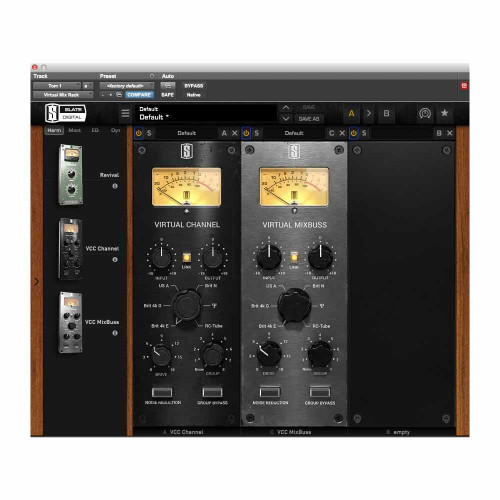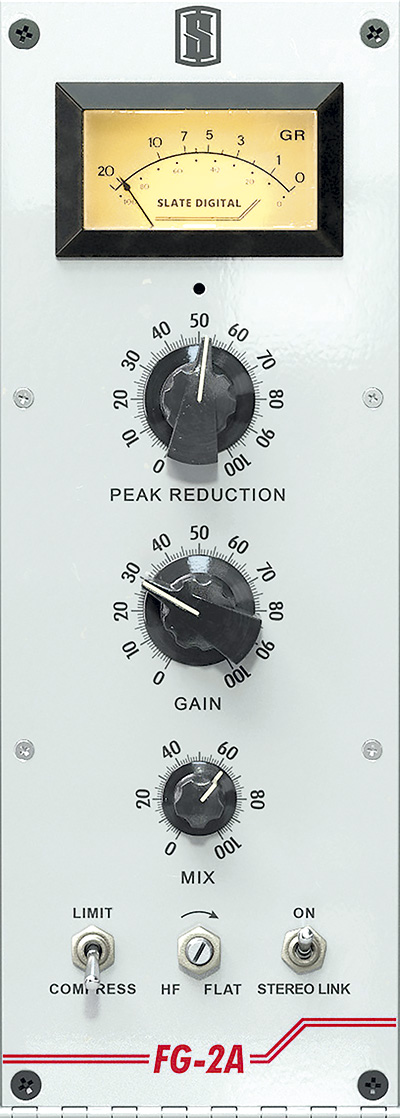

The output sections have pretty much no transformer saturation, making these models much more clean than the Vintage circuits. Both Modern versions feature slower attack times than the typical “fast” and “faster” times on the original units. These two models are the most interesting by far. Perfect for instruments who need to be heard, but featured. This model has more of a “smile EQ” effect with lush lows, tamed mids, and silky highs.

Circuit 2 is based on the refurbished model and responds to audio quite differently. This model is built for adding weight and presence to vocal track that won’t sit properly in a mix.

Circuit 1 has the standard mid-range centric push that places tracks out front in a mix while solidifying the low mids. These are selected via the circuit button. The Vintage model has been meticulously modeled after two different models of “Blue Stripe” REV A 1176 models. Both models feature the exact same controls, but with different colors on the GUI. Slate added several of the custom controls found in other VMR modules with 2 virtual “circuits” to select from, a high pass filter sidechain, and a mix knob to control how much compression is being blended with the signal. It’s the small things… Each model features the typical 1176 style settings complete with gain reduction meter, input, output, ratio button, attack and release. Try it… Open up 2 Vintage modules and look at how different the scratch marks and wear patterns are for both models. They definitely attract attention and still feature the “random virtual wear and tear per instance”.
#SLATE DIGITAL VMR REVIEW PRO#
Friends who know nothing about pro audio walk up behind the desk and immediately mention how detailed and sleek these models look. Yes, we know looks mean nothing to a mix, but the interfaces on these models are some of the best looking Slate digital has designed yet. Some of the questions at the beginning of this review are slowly being answered right? This disables compression and allows for the coloration to be used exclusively as an effect.
#SLATE DIGITAL VMR REVIEW PLUS#
The preamp feature is a plus that incorporates the modeled analog circuit by “Shift Clicking” the attack button.
#SLATE DIGITAL VMR REVIEW SERIES#
Essentially, the FG-116 BLUE Series contains 4 separate compressors and preamps. I’m sure these models are still loosely based on the original hardware version used in the Vintage model, but Slate decided step outside of the box and create his “ideal” 1176 models. For the Modern version, who knows what was used. Each Vintage version is based off of 2 REV A 1176s – one is a completely original model (circuit 1) while the other unit was refurbished in a way that altered the overall tone (circuit 2). The FG-116 BLUE Series compressors are modules that work within Slate’s Virtual Mix Rack (Review HERE) and come in two main iterations: Vintage and Modern. Instead of spending time analyzing each aspect of this plugin, then writing, I’m going to review it in print, as I’m working with the plugin. I’m going to take a slightly different approach to this review. Let’s tackle these questions one at a time because when I got the press release, each of these questions popped in my head.

Why do I need another one? Why should I shell out $200.00 for something I already have?įirst off calm down! I’m just a news site. Oh look, another 1176 emulation! But I have 30 of them INCLUDING the FG-116 already in the Virtual Mix Rack.


 0 kommentar(er)
0 kommentar(er)
